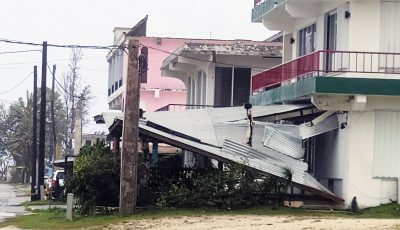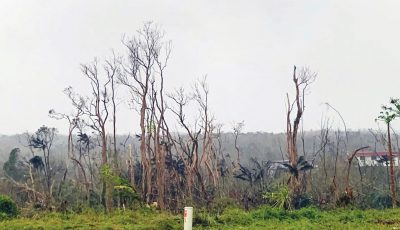Programmatic Agreement: An expression of power, privilege, and domination by the Pentagon
The Final Programmatic Agreement, or “PA,” is a document made up of a final PA section and four appendices—A, B, C, and D. Last month we talked about the final PA section and appendix A. Today we will complete a cursory discussion of appendices B, C, and D, closing with some thoughts on the need to further demystify, improve, and incorporate Chamorro perspectives into the PA.
Appendix B: What is it?
Appendix B is a five-page document titled “Standard Operating Procedure Regarding the Discovery of Human Remains on Guam.” It lays out a four-step process for how to manage the uncovering of human skeletal remains. The steps are: 1) initial discovery, 2) preliminary identification, 3) identification, age of deposition (time-period) and ethnicity, and 4) disposition.
Step I – Initial Discovery and Step II – Preliminary Identification lay down responsibilities to be performed by the military. These steps do not contain language that addresses how the government of Guam involves itself in determining whether remains are human or animal. Language explaining when the government of Guam representative is to take the lead or be a co-decision maker on discovery matters is missing.
Step III – Identification, Age of Deposition (time-period) and Ethnicity assigns advantage to an archaeologist to identify remains based solely on American national government qualifications for the job. It is presumed that this archaeologist is on the military’s payroll. If this is correct, it makes the archaeologist an individual who is not incentivized to represent the interests of the ancient Chamorro people of Guam.
Step III includes a few lines referencing how the government of Guam will be involved on matters of disposition. The State Historic Preservation Office is given little or no power throughout this appendix and our ancient Chamorro people are not afforded real and equal say when it comes to how skeletal remains are identified, deposed, and managed.
Non-federal government organizations who have an interest in Chamorro ancestral remains must submit written requests to SHPO if they want to involve themselves in the consultative process. This makes little sense, and it also provides cover for the Navy to indirectly discourage outside parties and the public from gaining fuller comprehensions of our ancestral remains, through how SHPO is positioned in the administrative control process.
Step IV – Disposition cites one government of Guam policy guideline and two federal statutes that cover archeological matters. The Navy maintains total control of the process. The language contained in Step IV is framed and intended to heavily benefit the military because all decisions regarding military-sponsored destructive clearing actions are made based on whether the military decides if it will or if will not entertain modifications to planned work.
Appendix C: What is it?
Appendix C represents the stated belief of the military that the signing and implementation of the PA has satisfied Sections 106 and 110(f) responsibilities for all military training and testing areas in Guam and surrounding waters. The appendix states that the compliance documents are the 2010 MIRC EIS/OEIS, the 2015 MITT EIS/OEIS, and the 2020 MITT SEIS. Only one reference is made to a government of Guam guideline.
Appendix D: What is it?
Appendix D is a named listing of 32 archeological or cultural resource reports produced over a 22-year period. One individual co-authored nine reports, another co-authored four reports, and several individuals co-wrote two reports. It appears that no Chamorros authored or co-wrote any of the reports. No citations are provided which shows the participation of island fisherman, elders, farmers, ranchers, Chamorro healers, policy makers, the Guam Mayors Council, or the governor.
Some final observations
The entire Final PA document cited the word “Chamorro” once in appendix B. The word “Chamorro” is not mentioned in appendices A, C, and D and in the Final PA section. Several federal statutes, environmental impact statements made up of thousands of pages, and one government of Guam reference are cited.
Appendices give full power and advantage to the American national government, its employees/representatives, and its cultural resource managers while extending little, if any, meaningful participation, and decision-making power to the government of Guam representative[s]. The Chamorro people of Guam are made invisible throughout this document because our people, language, and culture are omitted in the body’s content.
Definitions of terms used throughout the Final PA are absent. Icons, symbols, vertical legends, and horizontal legends found in all PowerPoint maps have no glossaries. The quality of visual locational information embedded in the PowerPoint pictures makes it impossible for the public to clearly and specifically understand where most or all site locations are in relation to village areas, the aquifer system, and microenvironments.
No specific explanations are given on fire, storm capture, water runoff, or human health risks to villagers, military personnel, and the environment. Language is missing that outlines liquid waste, solid waste, aerosolized waste, weight equivalents, and chemical compositions that are or will be produced and released into the environment.
The document is a representation of the violation of our human rights as ancient Chamorro Pacific Islanders, and because of this, the Final PA can be interpreted as an assault to our collective intelligence and rightful place as the only ancient Pacific Islander civilization that is most deeply rooted and solely indigenous to the Marianas archipelago.
Opportunities to improve the Final PA abound. Considerations include simplifying, reorganizing, or discarding the entire document, or producing major changes to the existing document to include several addenda, reflecting the unheard and legitimate needs, concerns, and desires of our ancient blue ocean continent civilization.
Until this document reflects and incorporates the concerns of our people of the southernmost Marianas Island of Guam in a readily understood fashion, and until the public comprehends to what extent the Pentagon is influencing, directing and/or pressuring the governor of Guam and SHPO to act or speak on its behalf, the work of the Final PA and its appendices remains unfinished and incomplete.



























